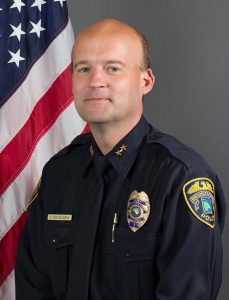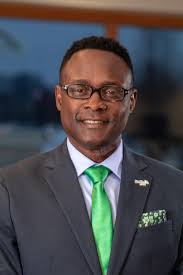Brooklyn Park Revisits Police Reform, Seeks Solutions to Recent Crime Surge
It was Aug. 9, 2014 when Michael Brown and a friend were walking in a Ferguson, Mo., street. A police officer told them to use the sidewalk. Words were exchanged. The situation escalated into a scuffle between the officer, who was white, and Brown, who was Black. The officer shot and killed Brown, who was unarmed.
The shooting touched off months of unrest not only in the St. Louis suburb but across the nation. It spurred a national debate about police treatment of persons of color. The impact was felt by Craig Enevoldsen, who became police chief of Brooklyn Park in late 2013.
Then on May 25, nearly six years later, George Floyd died under the knee of a Minneapolis police officer. Enevoldsen and the Brooklyn Park Police Department felt the impact even more.
“The sense of urgency around police reform since the incident with George Floyd, that’s not new to us in law enforcement,” Enevoldsen told city council members at a meeting this past week. “And the reason I can say that is, the issue of police accountability and police transparency and police reform became an issue for law enforcement following the death of Michael Brown.”
Police Reform in Brooklyn Park

Brooklyn Park Police Chief Craig Enevoldsen
Since Brown’s death, Brooklyn Park police worked on several ways to improve transparency and accountability. Enevoldsen pointed to former President Barack Obama’s Task Force on 21st Century Policing, which produced a blueprint for police reform in 2015. Brooklyn Park police now use a software tracking system that alerts supervisors if an officer has indicators of either of using too much excessive force or an abundance of discretionary arrests.
Brooklyn Park police was also one of the first suburbs along with Burnsville to put on body-worn cameras. It now publishes traffic stop data by race and by gender as well. And it partnered with the University of Minnesota for a review of the city’s hiring practices in efforts to hire more officers of color to match the city’s diversity.
According to Enevoldsen, the U of M report had one big takeaway. “You’re just going to have to find individuals one by one. You’re never going to be able to put out perfect job postings, have a perfect process, and have a large diverse pool of candidates. You actually have to go out and find them,” the chief said.
That led Brooklyn Park police to look into high schools. School resource officers taught classes around law enforcement, Enevoldsen said. It allowed the department to connect with families about the city’s cadet program, which will pay for a prospective officer’s tuition. The effort helped. The city brought in five diverse cadets who will become licensed police officers in January. Barring retirements, that will bring the department up to 105 officers, one shy of full authorization.
However, there’s still work to be done. This year there are 18 persons of color who are sworn officers in Brooklyn Park. In 2010, the city had 8.
“It’s difficult in the sworn ranks because of the profession that we have. We don’t have a lot of turnover,” said Enevoldsen.
Efforts Unravel, Crime Spikes
The COVID-19 pandemic didn’t help the crime picture. Domestic calls increased. But since the death of George Floyd, distrust in police grew. Crime exploded.
Enevoldsen says the city Minneapolis has exceeded all its homicides and shots fired cases from 2019 in just a four-month span.
“That’s beginning to spill over into Brooklyn Park,” the chief said.
 According to Brooklyn Park police statistics, from June 1 to Sept. 7, there have been 39 confirmed shots fired incidents. Out of those 39 cases, 18 people were shot and injured, two fatally. Pinpointing a trend has been difficult.
According to Brooklyn Park police statistics, from June 1 to Sept. 7, there have been 39 confirmed shots fired incidents. Out of those 39 cases, 18 people were shot and injured, two fatally. Pinpointing a trend has been difficult.
“This is a lot more complex because it’s occurring all over. The individuals involved in the shootings and the individuals getting shot are not necessarily from Brooklyn Park. They’re from all over the metro area,” Enevoldsen said.
And it’s not just crime that has increased. The level of animosity shown toward police trying to process crime scenes has grown too.
“We’re basically viewed as the enemy as soon as we show up,” the chief said.
He pointed to an incident at the Park Haven Apartments in the 6900 block of 76th Ave. N. two weeks ago. Three men had been shot. One of them died at the scene. The chief said people were tearing away police tape. Brooklyn Park police had to call in the State Patrol and neighboring departments.
“We were outnumbered,” Enevoldsen told city council members. “We’re getting zero cooperation at these crime scenes.”
The crime spike has also led to an increase in Brooklyn Park citizens seeking gun permits. The 5-year average is 665. This year, so far, it’s 1,120.
Concerns for 2021

Wynfred Russell, Brooklyn Park City Council member
Wynfred Russell’s, the city’s lone Black council member, says he understands the issue of race relations with police. But he admits trying to wrap his head around the ambivalence now seen toward the Brooklyn Park Police Department.
“Am I naive to think that this is new territory?” he asked the chief at Monday’s meeting.
Enevoldsen believes the George Floyd incident has hurt every police department.
“We knew we had taken a step back in police community relations. We knew that,” the chief said. “But I think we were all somewhat unprepared for the lawless behavior.”
The city’s police chief is also looking ahead. He has the month of March on his mind. That’s when four former Minneapolis police officers accused in the death of George Floyd will stand trial.
“I have some real serious concerns going into 2021,” the chief said. “And the reason I have some real serious concerns is we’re going to have that trial.”
City May Turn to Faith Leaders
As the city assesses its next steps, city leaders spoke openly about bringing in diverse faith leaders to be part of the solution. Brooklyn Park City Council member Lisa Jacobson said she and Brooklyn Park Mayor Jeff Lunde met last weekend with the families of Jamar Clark, Philando Castile and George Floyd. Clark and Castile, also both Black, were killed by police in 2015 and 2016 respectively. None of the cases happened in Brooklyn Park.
“One of the things that struck me at that event was the significant need for people of faith to be involved in the work that needs to be done,” said Jacobson. “I think that is a big chunk of an answer here.”
The city’s Human Rights Commission is also currently looking at ways to improve policing. Its recommendations could come this fall.
Brooklyn Park City Council member Susan Pha says she’s heard from residents who want action now.
“This is the most critical, most important time for us to make a difference, a real impact in what will come in the future.” said Pha. “It does not take burning of buildings for us to do something.”


